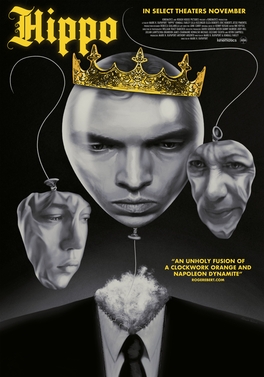In HIPPO, the collision of two opposing forces—innocence and destruction, devotion and apathy, love and chaos—creates a gripping tragicomic coming-of-age story. The novel examines the lives of two step-siblings: Hippo, an adolescent consumed by video games and the allure of digital warfare, and Buttercup, a Hungarian Catholic immigrant whose heart beats for classical music and the divine. Their relationship mirrors ancient mythological themes, particularly the tragic unrequited love of Aphrodite, but with a modern twist: rather than existing in the world of gods and heroes, their battlefield is the fraught terrain of teenage life, where hormones, trauma, and identity collide in an emotional inferno.
Hippo and Buttercup: The Tragic Divide Between Love and Apathy
At the heart of HIPPO is the relationship between its two protagonists: Hippo, an emotionally disengaged teenager, and Buttercup, his idealistic, deeply romantic step-sister. Their dynamic is a study in opposites. Hippo, addicted to video games, thrives in a world of artificial violence and strategic destruction. He embodies a generation raised on digital conflict, where war is entertainment and human connection is secondary. His worldview is cynical, shaped by the cold logic of online battles, where winning is the only objective and empathy is a liability.
Buttercup, on the other hand, is a beacon of passion. As a Hungarian Catholic immigrant, she brings with her an Old-World reverence for beauty, art, and faith. She is devoted to classical music and views the world through a lens of spiritual and aesthetic appreciation. Her love for Jesus is mirrored in her love for Hippo both are sources of salvation to her, even if one remains indifferent.
The novel plays on the classical motif of unrequited love, akin to the myth of Aphrodite and Adonis. In this case, Buttercup, the embodiment of love and devotion, directs her affections toward someone incapable of reciprocating them. Hippo’s rejection is not one of cruelty, but of emotional detachment he simply does not exist in the same realm of feeling as Buttercup. While she listens to Chopin, he listens to the gunfire of his console; while she prays, he strategizes his next in-game move. The contrast is stark, yet tragically comedic in its absurdity.
Technology as a Barrier to Human Connection
One of the most poignant commentaries in HIPPO is the role of technology in modern alienation. Hippo’s obsession with video games is more than just a teenage past-time it is a symptom of a greater detachment from reality. The novel critiques how digital entertainment, particularly violent video games, can act as both a refuge and a prison. For Hippo, the virtual world is safer than the real one. He can engage in combat without consequences, interact without vulnerability, and exist without expectation.
Buttercup’s presence challenges this detachment. She represents everything tangible music, faith, human affection but Hippo resists. His response to her love is not outright rejection, but a passive indifference, as if love itself is an outdated concept, incompatible with his reality. In a world where relationships are increasingly mediated through screens, HIPPO questions whether genuine human connection is becoming obsolete.
The novel does not take a one-sided stance, however. It acknowledges the comfort Hippo finds in his digital world. For many, video games provide a sense of control, community, and achievement that the real world often withholds. Hippo’s escape is not entirely a vice; it is his way of navigating a world that feels alien to him. Yet, in choosing this path, he isolates himself from the messy, painful, but deeply human experiences that Buttercup offers.
Faith vs. Nihilism: The Struggle for Meaning
Buttercup’s Catholic faith serves as another major thematic pillar in the novel. Her religious devotion is not just ritualistic but deeply personal. She finds solace in prayer, sees beauty in suffering, and believes in a divine order that gives life meaning. Her faith extends beyond religion it is evident in her love for music, her romantic ideals, and her unwavering belief that love can redeem even the most apathetic heart.
Hippo, by contrast, represents a nihilistic counterpoint. He does not actively oppose faith; he simply sees no relevance in it. His world is governed by logic, probability, and strategy faith, to him, is as absurd as romance. He does not rage against God, nor does he seek meaning in chaos. He simply exists, moving from one virtual battle to the next, detached from any deeper purpose.
This clash of worldviews creates some of the novel’s most compelling conflicts. Buttercup’s attempts to save Hippo whether through religion, music, or love are met with a blank stare, not hostility. The novel does not frame Hippo as the antagonist; rather, he is a product of his environment, a teenager shaped by a world that rewards detachment. Buttercup’s frustration is not with his rejection of her, but with the realization that he may be unreachable.
The Grotesque Absurdity of Adolescence
One of the most striking aspects of HIPPO is its blending of tragedy and comedy. The novel operates in a heightened reality, where teenage emotions are exaggerated to grotesque proportions. Hormones, heartbreak, and existential dread collide in scenes that are both painfully relatable and absurdly exaggerated. This tragicomic approach captures the essence of adolescence a period where everything feels like the end of the world, yet nothing is taken seriously.
The novel revels in its grotesque elements: Hippo’s gaming-induced isolation, Buttercup’s melodramatic religious fervor, the chaotic energy of high school life. Yet, beneath the humor lies a raw emotional truth. Adolescence is inherently ridiculous, but that does not make it any less painful. The novel balances this absurdity with genuine pathos, ensuring that the characters never become caricatures.
This blending of humor and tragedy recalls the works of writers like J.D. Salinger and Ottessa Moshfegh, who capture the alienation of youth with a mix of biting wit and deep melancholy. Like The Catcher in the Rye, HIPPO presents a protagonist who is both frustratingly detached and deeply sympathetic. Like My Year of Rest and Relaxation, it explores the allure of numbness in a world that demands engagement.
Final Thoughts
At its core, HIPPO is a novel about the struggles of a generation caught between detachment and longing. Hippo and Buttercup represent two opposing forces: one immersed in the virtual, the other devoted to the tangible. Their tragic dynamic speaks to a broader cultural conflict between technology and tradition, nihilism and faith, isolation and connection.
The novel does not offer easy answers. It does not condemn Hippo’s disaffection, nor does it fully endorse Buttercup’s romantic idealism. Instead, it presents their story as a reflection of contemporary adolescence, where love and meaning feel increasingly elusive.
In the end, Buttercup’s love remains unrequited, just as Aphrodite’s was. But unlike the myths of old, where divine figures shape human fate, HIPPO reminds us that the gods have long since abandoned us. In their place, we are left with video games, music, and the desperate hope that someone, somewhere, will finally look up from their screen and see us.
No comments yet.







